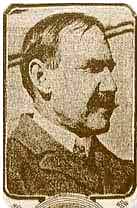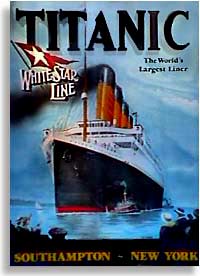DR. DODGE GIVES STORY OF RESCUE
Several Boats Lowered Only Half Filled;
“Tumbled In” When Told to.
By Dr. Washington Dodge
 NEW YORK, April 20.–“At 10 p.m. Sunday while my wife and I went out for a stroll along the Titanic’s promenade deck we found the air icy cold–so cold, in fact, that we were driven inside although we had on heavy wraps. This change of temperature had occurred in the previous two hours. We went to bed and were awakened about 11:40 by a jar which gave me the impression that a blow on the side had moved the entire vessel laterally to a considerable angle. With only my overcoat and slippers, I went through the companion way, but, to my surprise, found no one seriously considering the shock. NEW YORK, April 20.–“At 10 p.m. Sunday while my wife and I went out for a stroll along the Titanic’s promenade deck we found the air icy cold–so cold, in fact, that we were driven inside although we had on heavy wraps. This change of temperature had occurred in the previous two hours. We went to bed and were awakened about 11:40 by a jar which gave me the impression that a blow on the side had moved the entire vessel laterally to a considerable angle. With only my overcoat and slippers, I went through the companion way, but, to my surprise, found no one seriously considering the shock.
“Men in evening clothes stood about chatting and laughing, and when an officer–I did not know his name–hurried by I asked, ‘What is the trouble?’ He replied:
‘Something wrong; something is wrong with the propeller; nothing serious.’
“I went back to my stateroom, where my wife had already arisen to dress herself and I dissuaded her from dressing herself or our four-year-old son.
 “A little while later, still feeling nervous, I went up to the promenade deck and there saw a great mass of ice close to the starboard rail. Going back to my cabin again, I met my bedroom steward, with whom I had crossed the ocean before, who whispered to me that ‘Word has come from down below for everyone to put on life preservers.’ “A little while later, still feeling nervous, I went up to the promenade deck and there saw a great mass of ice close to the starboard rail. Going back to my cabin again, I met my bedroom steward, with whom I had crossed the ocean before, who whispered to me that ‘Word has come from down below for everyone to put on life preservers.’
“I rushed back to my stateroom and told my wife the news and made her come up on deck with the baby, even half clothed. The boats on the starboard side were then suspended from the davits, but no passengers wanted to get in.
ROOM IN THE BOAT.
“It was a drop of fifty feet to the surface of the sea, and, apparently everybody considered that they were safer on the ‘unsinkable Titanic’ than in a small boat whose only propelling power was four oars. The first boat was only half filled, for the simple reason that no one would get aboard.
“Personally, I waited for the lifeboat to become filled, and then saw there was plenty of room I asked the officer at the rail, whose name I do not know, why I also could not get in, as there was plenty of room. His only reply was, ‘Women and children first,’ and the half-filled boat sheered off.
“Before the next boats were lowered passengers who had become excited were calmed by the utterances of the officers that the injury was trivial and that in case it proved serious at least four steamships had been summoned by wireless and would be on hand within an hour.
SAW WIFE IN BOAT.
“I watched the lowering of the boat in which my wife and child were until it was safely launched on an even keel, and then I went to the starboard side of the ship, where the boats with the odd numbers from one to fifteen were being prepared for dropping over the side.
“The thing that impressed me was that there was not sufficient men to launch the boats, and, as a matter of fact, when the ship went down there was still one boat on the davits and one on the deck.
“The peculiar part of the whole rescue question was that the first boats had no more than thirty passengers, with four seamen to row, while the latter boats averaged from forty to fifty, with hardly one person aboard who knew how to move an oar.
“All this time the Titanic had a slight list to port, but just after the collision Captain Smith, coming hurriedly up and inquiring what the list was and finding it eighteen degrees to starboard, said ‘My God!’ ”
SAILOR OFFERS STOCKINGS.
As there is always a touch of humor in the most gruesome of happenings, it is told by Mrs. Dodge that one of the sailors in the boat in which she embarked insisted on taking off his shoes and giving her his stockings, saying: “I assure you, mam, that they are perfectly clean. I just put them on this morning.”
“I waited until what I thought was the end,” continued Dr. Dodge. “I certainly saw no signs of any women or children on deck when I was told to take a seat in boat number thirteen. When lowered we nearly came abreast of the three-foot stream that the condenser pumps were still sending out from the ship’s side. We cried out and the flow halted. I cannot image how that was done.
“Another danger to us was that the boat in which [Bruce] Ismay escaped was lowered, owing to the angle of the sinking ship, almost directly above us. If it had come ten feet farther both boats would have gone to the bottom, but our yells and cries stopped this catastrophe also.
“TUMBLED IN.”
“When boat number [thirteen] was being lowered from the ‘A’ deck it stayed there for at least two minutes while the officers in charge were calling for more women and children. But as none responded the officers said (and I am sorry I do not know their names) ‘some of you men tumble in,’ and I ‘tumbled.’
“In my boat when we found ourselves afloat we also found that the four oars were secured with strands of tarred rope. No man in the crowd had a pocket knife, but one had sufficient strength in his fingers to tear open one of the strands. That was the only way in which we got our boat far enough away from the Titanic’s side to escape the volume of the condenser pumps.
“Here is another thing that I want to emphasize; only one of all the boats set adrift from the vessel’s side had a lantern. We had to follow the only boat that had one, and if it had not been for that solitary lantern possibly many of the other boats might have drifted away and gone down.
“To show how lightly even the executive officers of the ship took the matter of the collision is proven by the fact that the officer in charge of the boat in which my wife was saved refused to let his men row more than half a mile from the Titanic because that he would soon have orders to come back.
“We saw the sinking of the vessel. The lights continued burning all along its starboard side until the moment of its downward plunge. After that a series of terrific explosions occurred, I suppose either from the boilers or weakened bulkheads.
“And then we just rowed about until dawn when we caught sight of the port light of the Carpathia, and knew that we were saved.
BOATS WITHOUT PASSENGERS.
“One curious point I noticed is that the first two boats launched held only their crews. Half an hour later I was told by an officer that they were launched in that shape to stand by in case of accident to her small boats.
“But there were no accidents and practically nothing for these boats to do, so many valuable lives were lost.
“If a sea had been running I do not see how many of the small boats would have lived. For instance, on my boat there were neither one officer or a seaman. The only men at the oars were stewards, who could no more row than I could serve a dinner.
“While order prevailed until the last lifeboat had been lowered, hell prevailed when the officers, who had kept the steerage passengers below, with their revolvers pointed at them to prevent them from making their way to the upper deck.
STEERAGE PASSENGER SHOT.
“When the steerage passengers came up many of them had knives, revolvers and clubs and sought to fight their way to the two unlaunched, collapsible boats. Many of these were shot by the officers.
“Only one of the rafts floated, and even that did not float above the water’s edge. From 40 to 50 persons who had jumped overboard clambered aboard it and stood upon it, locked arm and arm together until it was submerged to a depth of at least 18 inches. They all tried to hold together, but when the Carpathia’s boat reached them there were only 16 left.
“The most horrible part of the story is that statement that several persons in the lifeboats saw, when the Titanic took her final plunge, that her four great smokestacks sucked up and carried down in their giant maws dozens of the third class passengers, then huddled together on the forward upper deck.”
The Bulletin
San Francisco, April 20, 1912
Return to the top of the page.
|